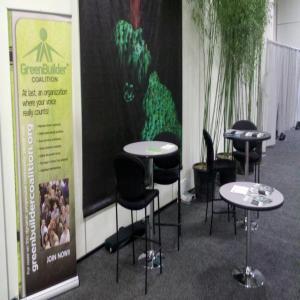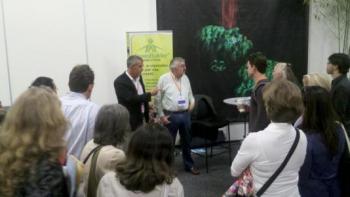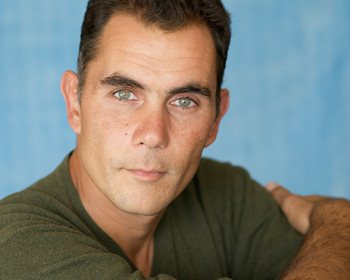- Green Builder® Coalition Attends Pacific Coast Builders Conference
- Update – North Carolina
- Update – International Green Construction Code
- Impact Series Returns July 5
- As I Am… Ingrid Mattsson
- Benefit Spotlight – Technical Assistance
- What’s Your Take? – We Don’t Need Building Codes or Green Building Programs, Do We?
Appearances
Green Builder® Coalition Attends Pacific Coast Builders Conference
The Green Builder® Coalition had a small presence at the 2011 Pacific Coast Builders Conference (PCBC) in San Francisco, CA. Located in the north hall of the Moscone Center, the show was attended by an estimated 10,000 people. According to those familiar with past conferences, overall attendance was markedly down from 2010, and off by as much as 80% from historical highs.
Spanning June 22-24, PCBC organizers put forth a valiant effort. The show had distinct areas highlighting specific topics of interest. A section of the floor was devoted to renewable energy, while another space housed information on outdoor living features. They also provided guided, topical tours of a few exhibitors. The destinations were left to the curator’s discretion. On Friday, one such group stopped by the Green Builder® Coalition/Green Builder® Media booth. The attendees, approximately 15-20 in total, spoke with Ron Jones and Mike Collignon.
 In speaking with a number of attendees, there didn’t seem to be much in the way of new products. However, we did encounter one product that might be of interest to some of our readers. (Green Builder® Coalition does not endorse this product; we merely provide this for informational purposes.) Phase Change Energy Solutions makes an insulation product that utilizes plant material to provide a mass effect for a structure. They’ve been using a similar technology in coolers and pizza delivery carriers for years, but have decided to produce this on a much larger scale. It will be interesting to see how the market reacts to this unique application.
In speaking with a number of attendees, there didn’t seem to be much in the way of new products. However, we did encounter one product that might be of interest to some of our readers. (Green Builder® Coalition does not endorse this product; we merely provide this for informational purposes.) Phase Change Energy Solutions makes an insulation product that utilizes plant material to provide a mass effect for a structure. They’ve been using a similar technology in coolers and pizza delivery carriers for years, but have decided to produce this on a much larger scale. It will be interesting to see how the market reacts to this unique application.
Activities
Update – north carolina
In our last issue, we reported on North Carolina’s struggle to pass an energy conservation code in a divided political situation. A compromise has been reached, and on June 8, 2011, a bill (S708-CSRO-20) was heard in the North Carolina state Senate Commerce Committee that would (on average) increase the energy efficiency of residential and commercial buildings by 15% and 30%, respectively. This bill passed, and on the morning of Friday, June 24th, Governor Perdue signed it. This means the bill will become law on January 1, 2012. There is a built-in 3-month transition period, so the law really doesn’t become mandatory until March 1, 2012.
The real winner in this saga is both the building owner and the environment. It is estimated that under the new law, a homeowner with a 1,800 sq. ft. home will realize an estimated $235 in annual energy savings. Assuming static energy costs, that represents a 6.4 year payback period. After that, it’s money (and energy) that would have been wasted for the remainder of the structure’s existence.
It is hoped that the initiative taken by Governor Perdue and the state of North Carolina will spread to other states, as they look for ways to stimulate their economies, job markets and subsequently their tax revenues. It should be noted, however, that the Governor had the unenviable task of persuading a state legislature ruled by the opposite party. She also got a diverse group of organizations to come to the table and compromise on this hotly-debated issue. The groups listed below, some of whom had been working on this issue for at least 9 months, should also get some of the spotlight for their efforts:
- North Carolina Sustainable Energy Association
- Environment North Carolina
- North Carolina Sierra Club
- Environmental Defense Fund
- North Carolina Homebuilders Association
- Appalachian State University
- North Carolina League of Conservation Voters
- Triangle Chapter of the USGBC
- City of Raleigh
Update – International Green Construction Code
For the second round of public hearings in Dallas in May 2011, there were three code change proposals submitted that attempted to reintroduce residential into the IGCC. These proposals were presented by the Green Builder® Coalition, USGBC, and the Council of Landscape Architectural Registration Boards (CLARB). The full proposals, which can be read on the ICC website, were numbered GG2-11, GG8-11 and GG12-11, respectively1. All three proposals were disapproved by the committee. (The summary of results can also be downloaded on the ICC website2.)
What was of interest is the prevailing opinion that ICC-700 should in no way be included in the IGCC. This is a stark reversal to the original draft, and what makes it more interesting is that there is some overlap between the members of the original development committee and the hearing committee in Dallas. Whether the committee was pressured by the Board to not undo the Board’s reversal or the committee wanted to send a clear rejection of ICC-700 is speculation. There is a theory that because ICC-700 is so much weaker than the recently passed 2012 IECC, there is a desire to remain equivalent to that in a brand new code. The most insightful feedback might not be from the committee, but rather a jurisdiction that would be expected to adopt and enforce such a code. In their words, they “found the ICC-700 problematic” and do not want to see it included in the IGCC.
The final action hearings for the IGCC will take place November 2-6, 2011 in Phoenix, AZ. At this hearing, the decision makers are not a small committee of industry representatives. Rather, it consists of hundreds of ICC governmental members, since they will be charged with enforcing the code once it is published and adopted by their jurisdictions. Public comments must be submitted to the ICC by August 12, 2011.3
In regards to the inclusion of residential, the Green Builder® Coalition has already had collaborative discussions with other organizations and individuals on the matter. A group has been formed to develop one or two strategies. Once drafted, the comment(s) will be submitted to the ICC. All comments will be available for public viewing on the ICC website starting September 16, 2011.
Impact Series Returns July 5
 Have you heard about the huge, floating island of plastic debris in the Pacific Ocean? It’s larger than the size of Texas! Learn more on Tuesday, July 5th at 1 pm (CT) as Marcus Eriksen, Ph.D. with Algalita Marine Research Foundation speaks about how the trash island was created and what we in the building industry can do to prevent it from growing. Just 2 days later, Marcus will embark on a 3-week eco-adventure, research voyage from Hawaii to the North Pacific Gyre, ending his voyage in Vancouver.
Have you heard about the huge, floating island of plastic debris in the Pacific Ocean? It’s larger than the size of Texas! Learn more on Tuesday, July 5th at 1 pm (CT) as Marcus Eriksen, Ph.D. with Algalita Marine Research Foundation speaks about how the trash island was created and what we in the building industry can do to prevent it from growing. Just 2 days later, Marcus will embark on a 3-week eco-adventure, research voyage from Hawaii to the North Pacific Gyre, ending his voyage in Vancouver.
To register for this webinar, please click here.
To view past webinars, they are archived here.
As I Am…
 Ingrid Mattsson
Ingrid Mattsson
Each issue, we’ll sit down with a green building professional to gain a personal insight into their motivations, inspirations and experiences. This issue, we feature Ingrid Mattsson, Sr. Brand Manager for Uponor.
The Torch: What motivated you to enter the sustainability industry?
Ingrid Mattsson: Well, from a “field” or “business” perspective, I would say that it was attending several green shows many years ago that were so inspiring and informative. Shows like EEBA, West Coast Green and NAHB’s Green Building Conference. It was like I had found the land of people who really cared about the important things in life – caring for the planet, slowing down the unnecessary waste and taking personal responsibility. From a “personal” perspective, though, I think I’ve always lived a more sustainable life in that I have immigrant parents who really taught us not to waste, to be respectful of the environment and to live a simpler life. I’m not saying I do it perfectly, but when I found the shows that I mentioned above, I felt like I immediately spoke their language and that was both comforting and exciting.
TT: Describe your first green project. Did you encounter any hurdles on that first project? If so, how did you overcome them?
IM: Since I’m not an actual builder, this is a tough question. But what I can say is that I feel really proud from a manufacturing perspective when I know Uponor’s products are contributing to a structure’s sustainability requirements – whether it’s radiant floor heating or cooling or saving water and energy through smarter PEX plumbing applications. Hurdles in general tend to be around a lack of understanding of what our products can provide as well as not understanding that sometimes paying a little more up front is a much greater value in the long run.
TT: What building product or technique do you think will be the next “game changer”?
IM: I believe there are already so many smart and wonderful products on the market that could be utilized to improve the situation immediately. If you really want to talk “game changer” though, then we’re talking attitudes and awareness. I know baby-step advancements are being made, but it’s too slow for the effects our current situation will have on the environment. We need our leaders, our communities and even individuals to support the belief that we need to change how we build and how we live. We need to take responsibility and move away from fast, easy, cheap and recognize that our resources are diminishing. The problem is we live in a world of denial, politics, power and money. Ultimately, perhaps the game changer is a catastrophe… sad to say.
TT: Who inspires you the most?
IM: I am inspired by the people who keep the faith. Those who keep fighting even in the face of terrible odds – could be in any field – sustainability, medicine, education. I know I have friends in the industry that I tap into regularly for encouragement and motivation.
TT: If you had it to do over again, what profession would you choose?
IM: When I was in school, it wasn’t on my radar at all, but through these years in the building industry, I have really come to appreciate architecture. Creativity abounds there; it is such a diverse field, and from a sustainable perspective, there is so much opportunity to do it right and have a positive effect on society. If I were to do it all over again, I’d study to be an architect. (That is of course if the rock star or Broadway gig didn’t work out.)
TT: What do you enjoy the most when you’re not at work?
IM: With all the time I spend in my garden these days, I guess I’d better say that I enjoy that most. It’s true – I love the design aspect, the breathtaking beauty of nature, the colors and the fact that you can get immediate satisfaction from your work. In addition to gardening, I’d have to say I love to travel, love to get together with family and friends and absolutely love the movies!
TT: What’s the most important piece of advice you’d like to pass along to others?
IM: Pay attention. And I mean that on so many levels. Right now, I think we’re living in a society where the problems are so very difficult and depressing, and as a result, we live in a “checked-out” society. It’s easier to focus on celebrities, reality stars and sports rather than demanding more of our leaders and demanding more of ourselves to come together to find solutions. These are hard times, and while I do believe we can have a very bright future ahead of us, I think people need to stop, pay attention and take responsibility for their own lives. Figure out what’s important to you and to our country and honor that.
Benefit Spotlight
Have you ever been in the middle of a design meeting and had no idea what your client meant when they wanted a home certified with Energy Star IAP? How about when they ask you if geothermal will work for their home?
Like the various standards to which a structure can be built, there are various ways that products and technology can be incorporated into a project. This means that a “one size fits all” approach to answering questions won’t help you achieve your sustainable goals.
A product or technology that is appropriate in one climate zone may be a complete dismal failure in another. But how would you know? Let us assist you in finding out! Our intention is to help reduce the hurdles or obstacles you might face when trying to adopt sustainable products and technologies. By presenting verifiable, unbiased information, we aim to provide the unique feedback you need to design, build or develop a more sustainable future. Whether you’re evaluating options for your next structure, or simply curious about a particular topic, the Coalition is here for you. Please submit your question to tech@greenbuildercoalition.org.
Voices
 What’s Your Take?
What’s Your Take?
we Don’t Need Building Codes or Green Building Programs, Do We?
Some time ago, the Chairman of our board wrote about the significance of the 56 signers of the Declaration of Independence in relation to the Green Builder® Coalition. What was emphasized is that, like the 56 signers, we are a group committed to the empowerment of the individual. Drawing another parallel, the Declaration of Independence and our country’s constitution were also created to empower the individual. Over the years, there have been many interpretations as to the intent of these documents; the results of which are many laws and regulations that restrict empowerment of the individual in some areas and remove personal responsibility in others.
William McDonough once said that regulation from a design perspective is a pure signal of design failure. To me, this places the blame on the design community for the public’s perceived need for building regulations. But is this accurate? As a practicing architect, there were times I needed to explain to a client (builder, developer, or otherwise) that something could not be done a certain way because of the building code. Architects are supposed to be the licensed guardians of the health, welfare and safety of the public. If we didn’t have the support of building codes, it’s virtually guaranteed that design conversations would only be about “value engineering”.
Now we have more stringent energy codes on the horizon. Many of these codes have incorporated sustainable tactics from voluntary green home building programs. What you may not be aware of is that there is a growing resistance to energy or “green” codes in general. In some states, the opposition has achieved reversal of energy efficiency legislation!
What’s the opposition’s primary argument? Cost. The same “cost” that has consistently allowed certified green homes to sell quickly and for a premium over conventionally built homes in a down market4. And, the builders of those certified homes used voluntary green home building programs that, for the most part, are more stringent than the current energy codes!
The market is telling us that it sees certified homes as quality built homes. Just building to code won’t “cut it” anymore. The same old, conventional, boring stuff is passé – yawn! In fact, Bill Black, the National Director of Strategic Business Solutions for Haworth, invented a great acronym for construction that just met code: CATNAP – Cheapest Available Technology, Narrowly Avoiding Prosecution.
We are now at a cross roads in the building community. We can either have the mindset that we are enslaved to legislated responsibility, or that we have liberty to build profitably. So, in honor of our country’s Independence Day, consider showing you are an empowered individual on your next project by voluntarily building beyond code.
Laureen Blissard
So, what’s your take? Log on to our Facebook page and share your thoughts.
[1] 2011 Proposed Code Changes, http://media.iccsafe.org/IGCC/docs/2011-ProposedChanges-IGCC.pdf (Caution: Large file)
[2] ICC, Dallas Daily Results, http://www.iccsafe.org/cs/IGCC/Documents/2011ProposedChanges/DallasDailyResults.pdf
[3] ICC Public Comment Form, http://www.iccsafe.org/cs/codes/Pages/publicforms.aspx
